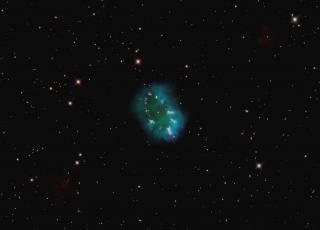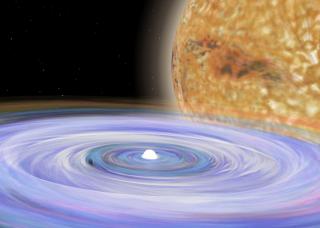Bibcode
Miszalski, B.; Jones, D.; Rodríguez-Gil, P.; Boffin, H. M. J.; Corradi, R. L. M.; Santander-García, M.
Bibliographical reference
Astronomy and Astrophysics, Volume 531, id.A158
Advertised on:
7
2011
Journal
Citations
70
Refereed citations
52
Description
We present observations proving the close binary nature of the central
stars belonging to the planetary nebulae (PNe) NGC 6326 and NGC 6778.
Photometric monitoring reveals irradiated lightcurves with orbital
periods of 0.372 and 0.1534 days, respectively, constituting firm
evidence that they passed through a common-envelope (CE) phase. Unlike
most surveys for close binary central stars (CSPN) however, the binary
nature of NGC 6326 was first revealed spectroscopically and only later
did photometry obtain an orbital period. Gemini South observations
revealed a large 160 km s-1 shift between the nebula and
emission lines of C III and N III well known to originate from
irradiated atmospheres of main-sequence companions. These so-called weak
emission lines are fairly common in PNe and measurement of their radial
velocity shifts in spectroscopic surveys could facilitate the
construction of a statistically significant sample of post-CE nebulae.
There is growing evidence that this process can be further accelerated
by pre-selecting nebulae with traits of known post-CE nebulae. Both NGC
6326 and NGC 6778 were selected for their rich attribution of
low-ionisation filaments and collimated outflows, thereby strengthening
the connection between these traits and post-CE CSPN.
Based on observations made with Gemini South under program
GS-2009A-Q-35, the South African Astronomical Observatory 1.9 m
telescope, the Flemish Mercator telescope of the Observatoria del Roque
de Los Muchachos, and the Very Large Telescope at Paranal Observatory
under program 085.D-0629(A).
Related projects

Bipolar Nebulae
This project has three major objectives: 1) To determine the physico-chemical characteristics of bipolar planetary nebulae and symbiotic nebulae, to help understanding the origin of bipolarity and to test theoretical models, mainly models with binary central stars, aimed at explaining the observed morphology and kinematics. 2) To study the low
Antonio
Mampaso Recio

Binary Stars
The study of binary stars is essential to stellar astrophysics. A large number of stars form and evolve within binary systems. Therefore, their study is fundamental to understand stellar and galactic evolution. Particularly relevant is that binary systems are still the best source of precise stellar mass and radius measurements. Research lines
Pablo
Rodríguez Gil